Laser Remote Sensing of Lake Kinneret by Compact Fluorescence LiDAR
Abstract
:1. Introduction
2. Materials and Methods
2.1. Location of the Experiment
2.2. LiDAR
2.3. LiDAR Instrument Calibration
3. Results and Discussion
3.1. LiDAR Monitoring of Chlorophyll Concentration
3.2. Water Temperature Sensing by LiDAR under High Algae Concentration
4. Conclusions
Author Contributions
Funding
Institutional Review Board Statement
Informed Consent Statement
Data Availability Statement
Acknowledgments
Conflicts of Interest
References
- McKibben, S.M.; Strutton, P.G.; Foley, D.G.; Peterson, T.D.; White, A.E. Satellite-based detection and monitoring of phytoplankton blooms along the Oregon coast. J. Geophys. Res. Ocean. 2012, 117, C12002. [Google Scholar] [CrossRef]
- Pan, G.; Tang, D.; Zhang, Y. Satellite monitoring of phytoplankton in the East Mediterranean Sea after the 2006 Lebanon oil spill. Int. J. Remote Sens. 2012, 33, 7482–7490. [Google Scholar] [CrossRef]
- Behrenfeld, M.J.; Westberry, T.K.; Boss, E.S.; O’Malley, R.T.; Siegel, D.A.; Wiggert, J.D.; Franz, B.A.; McClain, C.R.; Feldman, G.C.; Doney, S.C.; et al. Satellite-detected fluorescence reveals global physiology of ocean phytoplankton. Biogeosciences 2009, 6, 779–794. [Google Scholar] [CrossRef]
- Gons, H.J.; Auer, M.T.; Effler, S.W. MERIS satellite chlorophyll mapping of oligotrophic and eutrophic waters in the Laurentian Great Lakes. Remote Sens. Environ. 2008, 112, 4098–4106. [Google Scholar] [CrossRef]
- Tatem, A.J.; Goetz, S.J.; Hay, S.I. Fifty Years of Earth-observation Satellites Views from space have led to countless advances on the ground in both scientific knowledge and daily life. Am. Sci. 2008, 96, 390–398. [Google Scholar] [CrossRef]
- Blondeau-Patissier, D.; Gower, J.F.R.; Dekker, A.G.; Phinn, S.R.; Brando, V.E. A review of ocean color remote sensing methods and statistical techniques for the detection, mapping and analysis of phytoplankton blooms in coastal and open oceans. Prog. Oceanogr. 2014, 123, 123–144. [Google Scholar] [CrossRef]
- Hestir, E.L.; Brando, V.E.; Bresciani, M.; Giardino, C.; Matta, E.; Villa, P.; Dekker, A.G. Measuring freshwater aquatic ecosystems: The need for a hyperspectral global mapping satellite mission. Remote Sens. Environ. 2015, 167, 181–195. [Google Scholar] [CrossRef]
- Ermakov, S.; Sergievskaya, I.; da Silva, J.; Kapustin, I.; Shomina, O.; Kupaev, A.; Molkov, A. Remote Sensing of Organic Films on the Water Surface Using Dual Co-Polarized Ship-Based X-/C-/S-Band Radar and TerraSAR-X. Remote Sens. 2018, 10, 1097. [Google Scholar] [CrossRef]
- Kampel, M.; Lorenzzetti, J.A.; Bentz, C.M.; Nunes, R.A.; Paranhos, R.; Rudorff, F.M.; Politano, A.T. Simultaneous measurements of chlorophyll concentration by lidar, fluorometry, above-water radiometry, and ocean color MODIS images in the Southwestern Atlantic. Sensors 2009, 9, 528–541. [Google Scholar] [CrossRef]
- Shomina, O.; Danilicheva, O.; Tarasova, T.; Kapustin, I. Manifestation of Spiral Structures under the Action of Upper Ocean Currents. Remote Sens. 2022, 14, 1871. [Google Scholar] [CrossRef]
- Ermakov, S.A.; Kapustin, I.A.; Lazareva, T.N.; Sergievskaya, I.A.; Andriyanova, N. V On the possibilities of radar probing of eutrophication zones in water reservoirs. Izv. Atmos. Ocean. Phys. 2013, 49, 307–314. [Google Scholar] [CrossRef]
- Churnside, J.H. Review of profiling oceanographic lidar. Opt. Eng. 2013, 53, 51405. [Google Scholar] [CrossRef]
- Grishin, M.Y.; Lednev, V.N.; Pershin, S.M.; Bunkin, A.F.; Kobylyanskiy, V.V.; Ermakov, S.A.; Kapustin, I.A.; Molkov, A.A. Laser remote sensing of an algal bloom in a freshwater reservoir. Laser Phys. 2016, 26, 125601. [Google Scholar] [CrossRef]
- Bunkin, A.F.; Klinkov, V.K.; Lednev, V.N.; Lushnikov, D.L.; Marchenko, A.V.; Morozov, E.G.; Pershin, S.M.; Yulmetov, R.N. Remote sensing of seawater and drifting ice in Svalbard fjords by compact Raman lidar. Appl. Opt. 2012, 51, 5477–5485. [Google Scholar] [CrossRef] [PubMed]
- Bunkin, A.F.; Pershin, S.M. Laser Remote Sensing of Ocean, Soil, and Vegetation: Methods and Applications. Phys. Vib. 2001, 9, 43–51. [Google Scholar]
- Fiorani, L.; Angelini, F.; Artuso, F.; Cataldi, D.; Colao, F. Lidar Monitoring of Chlorophyll a During the XXIX and XXXI Italian Antarctic Expeditions. Int. J. Environ. Res. 2019, 13, 253–263. [Google Scholar] [CrossRef]
- Xu, P.; Liu, D.; Shen, Y.; Chen, Y.; Zhang, H.; Ye, Z.; Jiang, C.; Zhou, Y.; Liu, Q.; Liu, C. Design and validation of a shipborne multiple-field-of-view lidar for upper ocean remote sensing. J. Quant. Spectrosc. Radiat. Transf. 2020, 254, 107201. [Google Scholar] [CrossRef]
- Lund, J.W.G.; Kipling, C.; Le Cren, E.D. The inverted microscope method of estimating algal numbers and the statistical basis of estimations by counting. Hydrobiologia 1958, 11, 143–170. [Google Scholar] [CrossRef]
- Sournia, A. Phytoplankton Manual; UNESCO: Paris, France, 1978. [Google Scholar]
- McAlice, B.J. Phytoplankton Sampling with the Sedgwick-Rafter Cell. Limnol. Oceanogr. 1971, 16, 19–28. [Google Scholar] [CrossRef]
- Molkov, A.A.; Kapustin, I.A.; Shchegolkov, Y.B.; Vodeneeva, E.L.; Kalashnikov, I.N. On correlation between inherent optical properties at 650 nm, Secchi depth and blue-green algal abundance for the Gorky reservoir. Fundam. Prikl. Gidrofiz. 2018, 11, 26–33. [Google Scholar] [CrossRef]
- Paerl, H.W.; Fulton, R.S.; Moisander, P.H.; Dyble, J. Harmful freshwater algal blooms, with an emphasis on cyanobacteria. Sci. World J. 2001, 1, 76–113. [Google Scholar] [CrossRef] [PubMed] [Green Version]
- Lopez, C.B.; Jewett, E.B.; Dortch, Q.; Walton, B.T.; Hudnell, H.K. Scientific Assessment of Freshwater Harmful Algal Blooms. 2008. Available online: https://aquadocs.org/handle/1834/30787 (accessed on 26 July 2022).
- Klemas, V. Remote Sensing of Algal Blooms: An Overview with Case Studies. J. Coast. Res. 2012, 278, 34–43. [Google Scholar] [CrossRef]
- Herath, G. Freshwater algal blooms and their control: Comparison of the European and Australian experience. J. Environ. Manag. 1997, 51, 217–227. [Google Scholar] [CrossRef]
- Journey, C.A.; Beaulieu, K.M.; Knight, R.R.; Graham, J.L.; Arrington, J.M.; West, R.; Westcott, J.; Bradley, P.M. Harmful algal blooms: A case study in two mesotrophic drinking water supply reservoirs in South Carolina. In Proceedings of the 2010 South Carolina Water Resources Conference; Clemson University Center for Watershed Excellence: Columbia, SC, USA, 2010; p. 5. [Google Scholar]
- Biswas, T.K. Harmful Algal Blooms Management in the Australian Murray River. In Proceedings of the International Symposium in Commemoration of the 50th Anniversary of Korean Society of Limnology, Gwangju, Korea, 18 October 2017; p. 28. [Google Scholar]
- Lekki, J.; Deutsch, E.; Sayers, M.; Bosse, K.; Anderson, R.; Tokars, R.; Sawtell, R. Determining remote sensing spatial resolution requirements for the monitoring of harmful algal blooms in the Great Lakes. J. Great Lakes Res. 2019, 45, 434–443. [Google Scholar] [CrossRef]
- Timoshkin, O.A.; Samsonov, D.P.; Yamamuro, M.; Moore, M.V.; Belykh, O.I.; Malnik, V.V.; Sakirko, M.V.; Shirokaya, A.A.; Bondarenko, N.A.; Domysheva, V.M.; et al. Rapid ecological change in the coastal zone of Lake Baikal (East Siberia): Is the site of the world’s greatest freshwater biodiversity in danger? J. Great Lakes Res. 2016, 42, 487–497. [Google Scholar] [CrossRef]
- Schwarzenbach, R.P.; Gschwend, P.M.; Imboden, D.M. Ponds, Lakes, and Oceans. In Environmental Organic Chemistry; John Wiley & Sons: Hoboken, NJ, USA, 2003; p. 1052. [Google Scholar]
- Tyus, H.M. Ecology and Conservation of Fishes; CRC Press: Boca Raton, FL, USA, 2011; ISBN 9781439897591. [Google Scholar]
- Jia, T.; Zhang, X.; Dong, R. Long-Term Spatial and Temporal Monitoring of Cyanobacteria Blooms Using MODIS on Google Earth Engine: A Case Study in Taihu Lake. Remote Sens. 2019, 11, 2269. [Google Scholar] [CrossRef]
- Cao, M.; Mao, K.; Shen, X.; Xu, T.; Yan, Y.; Yuan, Z. Monitoring the Spatial and Temporal Variations in The Water Surface and Floating Algal Bloom Areas in Dongting Lake Using a Long-Term MODIS Image Time Series. Remote Sens. 2020, 12, 3622. [Google Scholar] [CrossRef]
- Ryan, J.P.; Gower, J.F.R.; King, S.A.; Bissett, W.P.; Fischer, A.M.; Kudela, R.M.; Kolber, Z.; Mazzillo, F.; Rienecker, E.V.; Chavez, F.P. A coastal ocean extreme bloom incubator. Geophys. Res. Lett. 2008, 35, L12602. [Google Scholar] [CrossRef]
- Hallegraeff, G.M. A review of harmful algal blooms and their apparent global increase. Phycologia 1993, 32, 79–99. [Google Scholar] [CrossRef]
- Testai, E.; Buratti, F.M.; Funari, E.; Manganelli, M.; Vichi, S.; Arnich, N.; Biré, R.; Fessard, V.; Sialehaamoa, A. Review and analysis of occurrence, exposure and toxicity of cyanobacteria toxins in food. EFSA Support. Publ. 2016, 13, 998E. [Google Scholar] [CrossRef]
- Tal, A. The implications of climate change driven depletion of Lake Kinneret water levels: The compelling case for climate change-triggered precipitation impact on Lake Kinneret’s low water levels. Sci. Total Environ. 2019, 664, 1045–1051. [Google Scholar] [CrossRef] [PubMed]
- Kinneret Limnological Laboratory. Available online: http://www.ocean.org.il/Eng/KineretDataCenter/ProfileDC.asp (accessed on 2 July 2022).
- Zohary, T.; Sukenik, A.; Berman, T.; Nishri, A. Lake Kinneret: Ecology and Management; Huisman, J., Ed.; Springer: New York, NY, USA, 2014; ISBN 9789401789431. [Google Scholar]
- Mayo, M.; Gitelson, A.; Yacobi, Y.Z.; Ben-Avraham, Z. Chlorophyll distribution in Lake Kinneret determined from Landsat Thematic Mapper data. Int. J. Remote Sens. 1995, 16, 175–182. [Google Scholar] [CrossRef]
- Yacobi, Y.Z.; Moses, W.J.; Kaganovsky, S.; Sulimani, B.; Leavitt, B.C.; Gitelson, A.A. NIR-red reflectance-based algorithms for chlorophyll-a estimation in mesotrophic inland and coastal waters: Lake Kinneret case study. Water Res. 2011, 45, 2428–2436. [Google Scholar] [CrossRef] [PubMed]
- Gitelson, A.; Mayo, M.; Yacobi, Y.Z.; Parparov, A.; Berman, T. The use of high-spectral-resolution radiometer data for detection of low chlorophyll concentrations in Lake Kinneret. J. Plankton Res. 1994, 16, 993–1002. [Google Scholar] [CrossRef]
- Dev, P.J.; Sukenik, A.; Mishra, D.R.; Ostrovsky, I. Cyanobacterial pigment concentrations in inland waters: Novel semi-analytical algorithms for multi- and hyperspectral remote sensing data. Sci. Total Environ. 2022, 805, 150423. [Google Scholar] [CrossRef] [PubMed]
- Gower, J.; King, S. Use of satellite images of chlorophyll fluorescence to monitor the spring bloom in coastal waters. Int. J. Remote Sens. 2012, 33, 7469–7481. [Google Scholar] [CrossRef]
- Ostrovsky, I.; Wu, S.; Li, L.; Song, L. Bloom-forming toxic cyanobacterium Microcystis: Quantification and monitoring with a high-frequency echosounder. Water Res. 2020, 183, 116091. [Google Scholar] [CrossRef]
- Grishin, M.Y.; Lednev, V.N.; Pershin, S.M.; Kapralov, P.O. Ultracompact Fluorescence Lidar Based on a Diode Laser (405 nm, 150 mW) for Remote Sensing of Waterbodies and the Underlying Surface from Unmanned Aerial Vehicles. Dokl. Phys. 2021, 66, 153–155. [Google Scholar] [CrossRef]
- Cadondon, J.G.; Ong, P.M.B.; Vallar, E.A.; Shiina, T.; Galvez, M.C.D. Chlorophyll-a Pigment Measurement of Spirulina in Algal Growth Monitoring Using Portable Pulsed LED Fluorescence Lidar System. Sensors 2022, 22, 2940. [Google Scholar] [CrossRef]
- Lu, X.; Hu, Y.; Trepte, C.; Zeng, S.; Churnside, J.H. Ocean subsurface studies with the CALIPSO spaceborne lidar. J. Geophys. Res. Ocean. 2014, 119, 4305–4317. [Google Scholar] [CrossRef]
- Zheng, H.; Ma, Y.; Huang, J.; Yang, J.; Su, D.; Yang, F.; Wang, X.H. Deriving vertical profiles of chlorophyll-a concentration in the upper layer of seawaters using ICESat-2 photon-counting lidar. Opt. Express 2022, 30, 33320. [Google Scholar] [CrossRef]
- Chekalyuk, A.; Hafez, M. Advanced laser fluorometry of natural aquatic environments. Limnol. Oceanogr. Methods 2008, 6, 591–609. [Google Scholar] [CrossRef]
- Hoge, E.F.; Swift, N.R. Airborne dual laser excitation and mapping of phytoplankton photopigments in a Gulf Stream Warm Core Ring. Appl. Opt. 1983, 22, 2272–2281. [Google Scholar] [CrossRef] [PubMed]
- Demtröder, W. Laser Raman Spectroscopy. In Laser Spectroscopy 2 Experimental Techniques; Springer: Berlin/Heidelberg, Germany, 2015; p. 149. ISBN 978-3-662-44640-9. [Google Scholar]
- Ninio, S.; Lupu, A.; Eckert, W.; Ostrovsky, I.; Viner Mozzini, Y.; Sukenik, A. Metalimnetic chlorophyll maxima in Lake Kinneret–Chlorobium revisited. Freshw. Biol. 2021, 66, 468–480. [Google Scholar] [CrossRef]
- Rimmer, A.; Ostrovsky, I.; Yacobi, Y.Z. Light availability for Chlorobium phaeobacteroides development in Lake Kinneret. J. Plankton Res. 2008, 30, 765–776. [Google Scholar] [CrossRef]
- Pšenčík, J.; Ma, Y.Z.; Arellano, J.B.; Hála, J.; Gillbro, T. Excitation energy transfer dynamics and excited-state structure in chlorosomes of Chlorobium phaeobacteroides. Biophys. J. 2003, 84, 1161–1179. [Google Scholar] [CrossRef]
- Palmer, S.; Pelevin, V.; Goncharenko, I.; Kovács, A.; Zlinszky, A.; Présing, M.; Horváth, H.; Nicolás-Perea, V.; Balzter, H.; Tóth, V. Ultraviolet Fluorescence LiDAR (UFL) as a Measurement Tool for Water Quality Parameters in Turbid Lake Conditions. Remote Sens. 2013, 5, 4405–4422. [Google Scholar] [CrossRef]
- Sliwka-Kaszyńska, M.; Kot-Wasik, A.; Namieśnik, J. Preservation and Storage of Water Samples. Crit. Rev. Environ. Sci. Technol. 2003, 33, 31–44. [Google Scholar] [CrossRef]
- FluoroProbe III: The Instrument for Depth Profiling of Microalgae. Available online: https://www.bbe-moldaenke.de/en/products/chlorophyll/details/fluoroprobe.html?file=files/knowledge-media/brochures/FluoroProbe_eng.pdf (accessed on 24 August 2022).
- Enright, J.T. Diurnal vertical migration: Adaptive significance and timing. Part 1. Selective advantage: A metabolic model. Limnol. Oceanogr. 1977, 22, 856–872. [Google Scholar] [CrossRef]
- Lou, X.; Hu, C. Diurnal changes of a harmful algal bloom in the East China Sea: Observations from GOCI. Remote Sens. Environ. 2014, 140, 562–572. [Google Scholar] [CrossRef]
- Leonard, D.A.; Caputo, B.; Hoge, F.E. Remote sensing of subsurface water temperature by Raman scattering. Appl. Opt. 1979, 18, 1732–1745. [Google Scholar] [CrossRef]
- Lednev, V.N.; Grishin, M.Y.; Pershin, S.M.; Bunkin, A.F. Quantifying Raman OH-band spectra for remote water temperature measurements. Opt. Lett. 2016, 41, 4625–4628. [Google Scholar] [CrossRef] [PubMed]
- Bunkin, F.A.; Voliak, K. Laser Remote Sensing of the Ocean: Methods and Applications; Wiley: Weinheim, Germany, 2001; ISBN 0471389277. [Google Scholar]
- Levring, T.; Hoppe, H.A.; Schmid, O.J. Marine Algae: A Survey of Research and Utilization; Walter de Gruyter GmbH & Co KG: Hamburg, Germany, 1969. [Google Scholar]
- Snow, G.C. Determining the health of river-dominated estuaries using microalgal biomass and community composition. South African J. Bot. 2016, 107, 21–30. [Google Scholar] [CrossRef]
- Kislik, C.; Dronova, I.; Kelly, M. UAVs in Support of Algal Bloom Research: A Review of Current Applications and Future Opportunities. Drones 2018, 2, 35. [Google Scholar] [CrossRef] [Green Version]





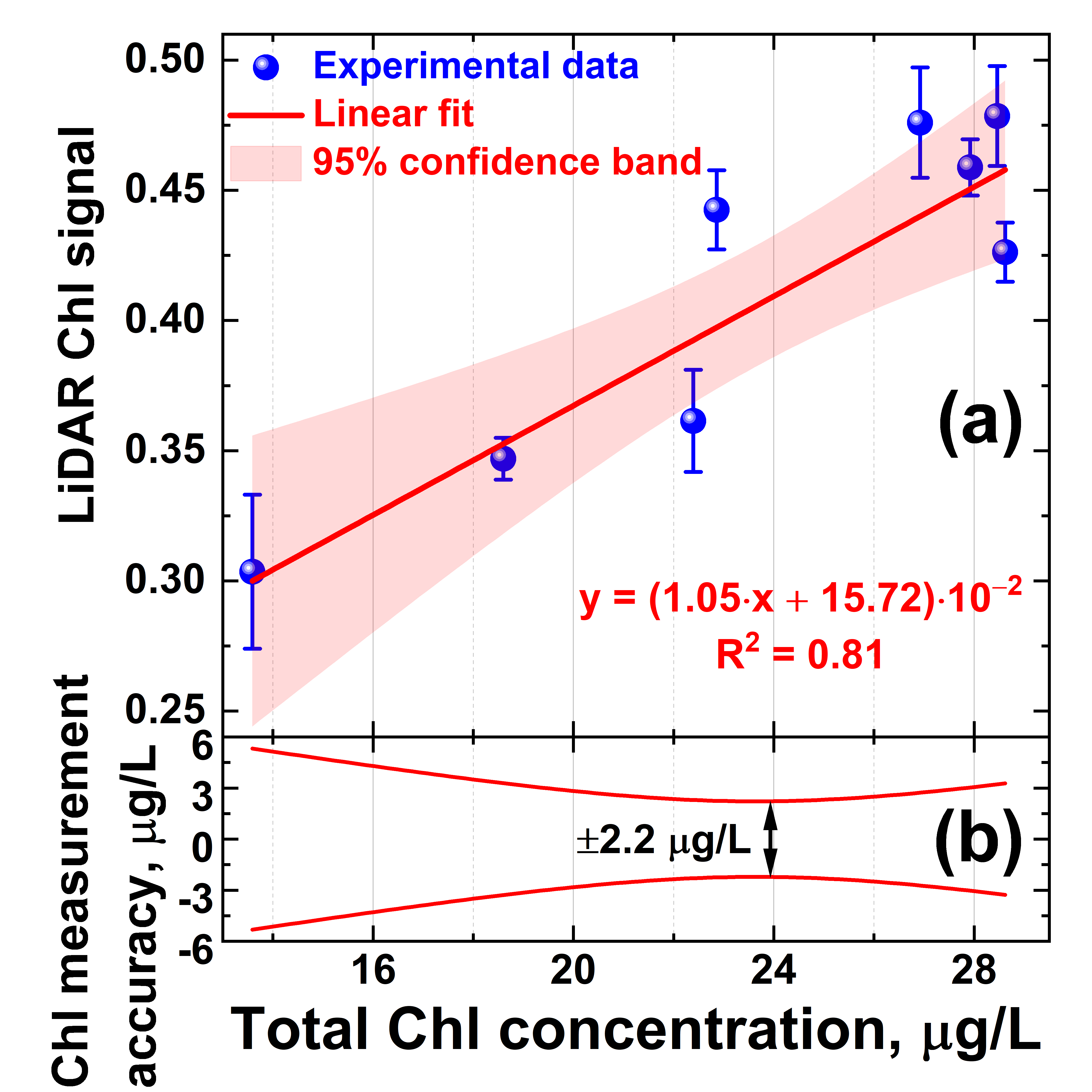
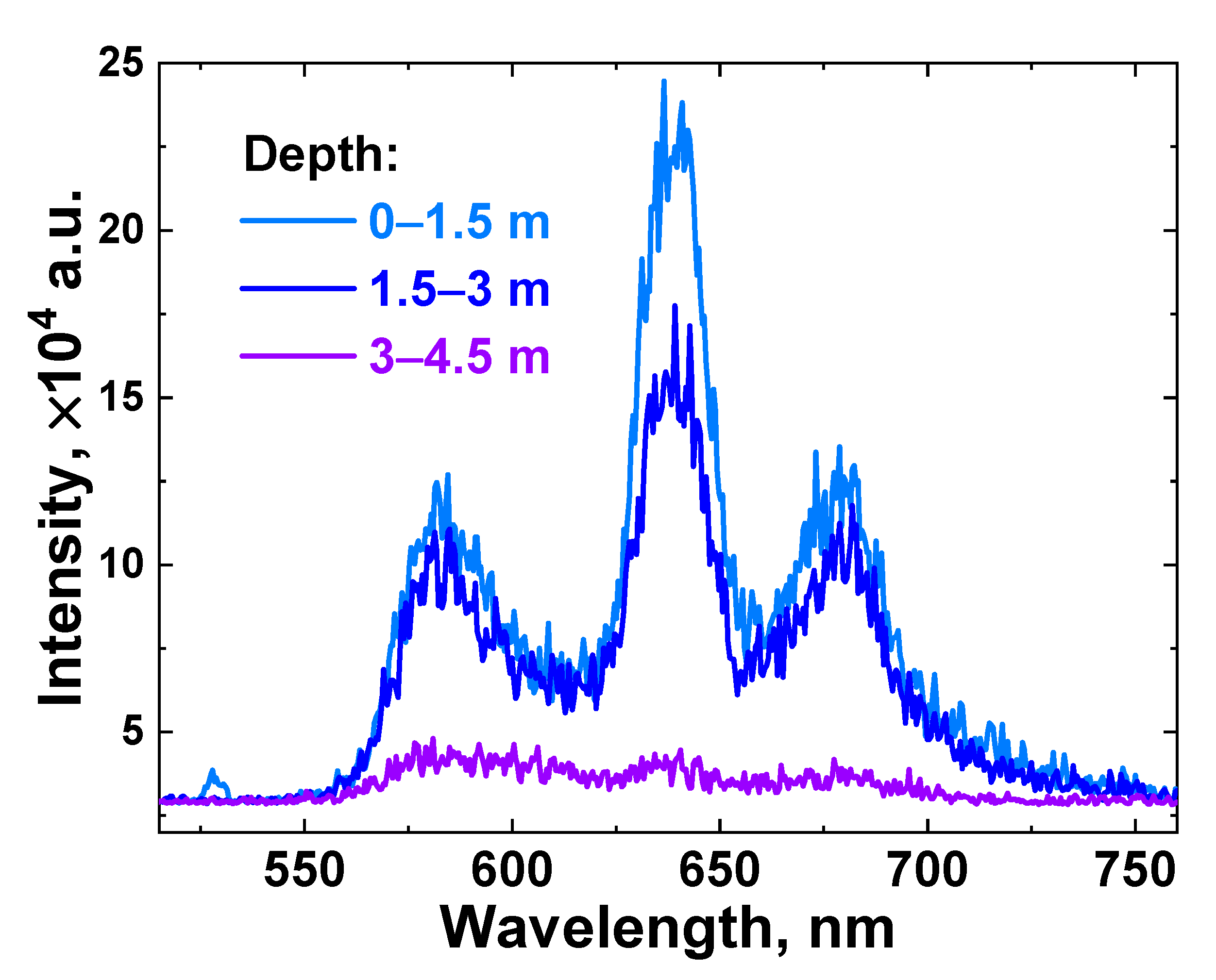
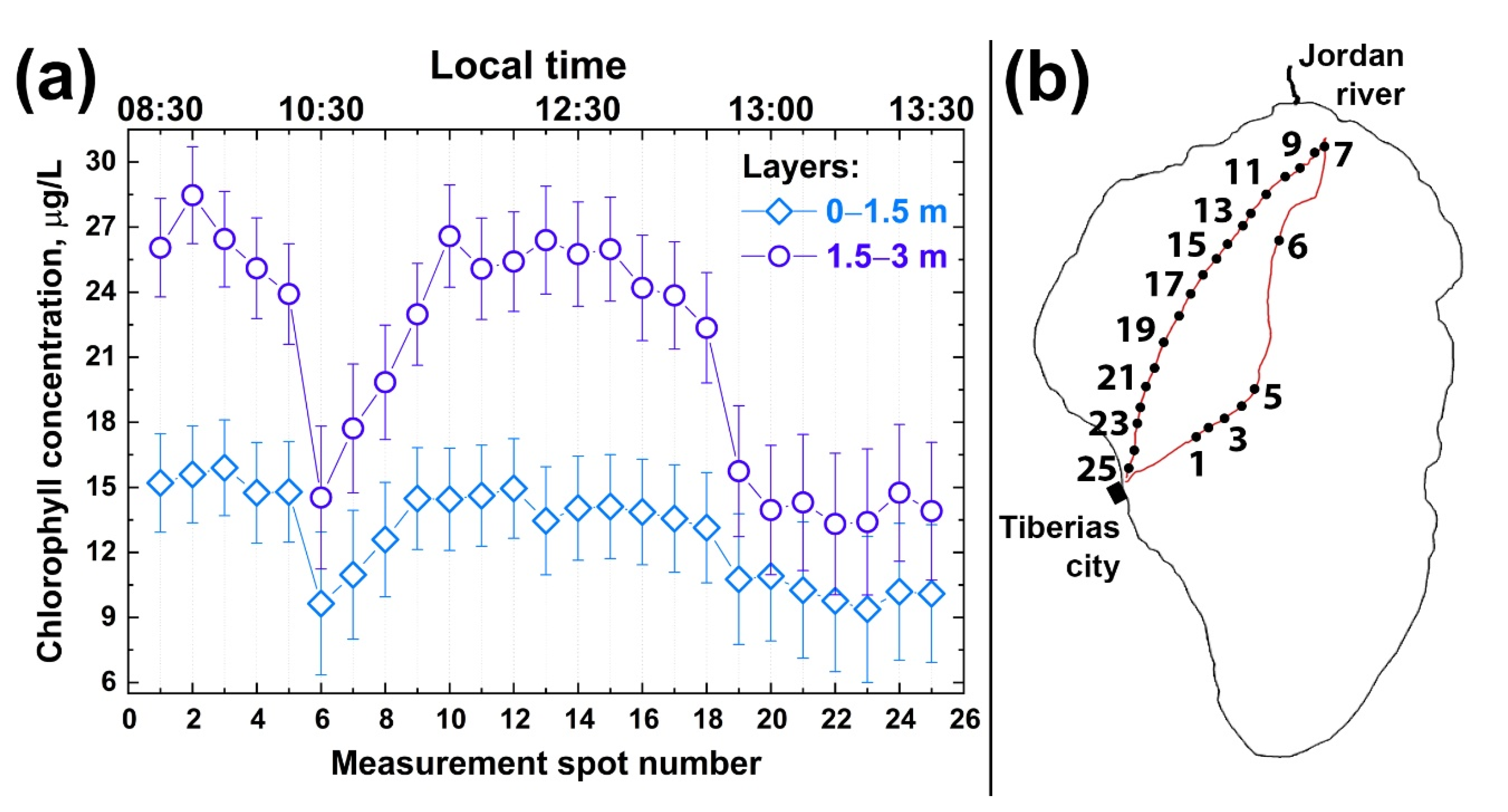
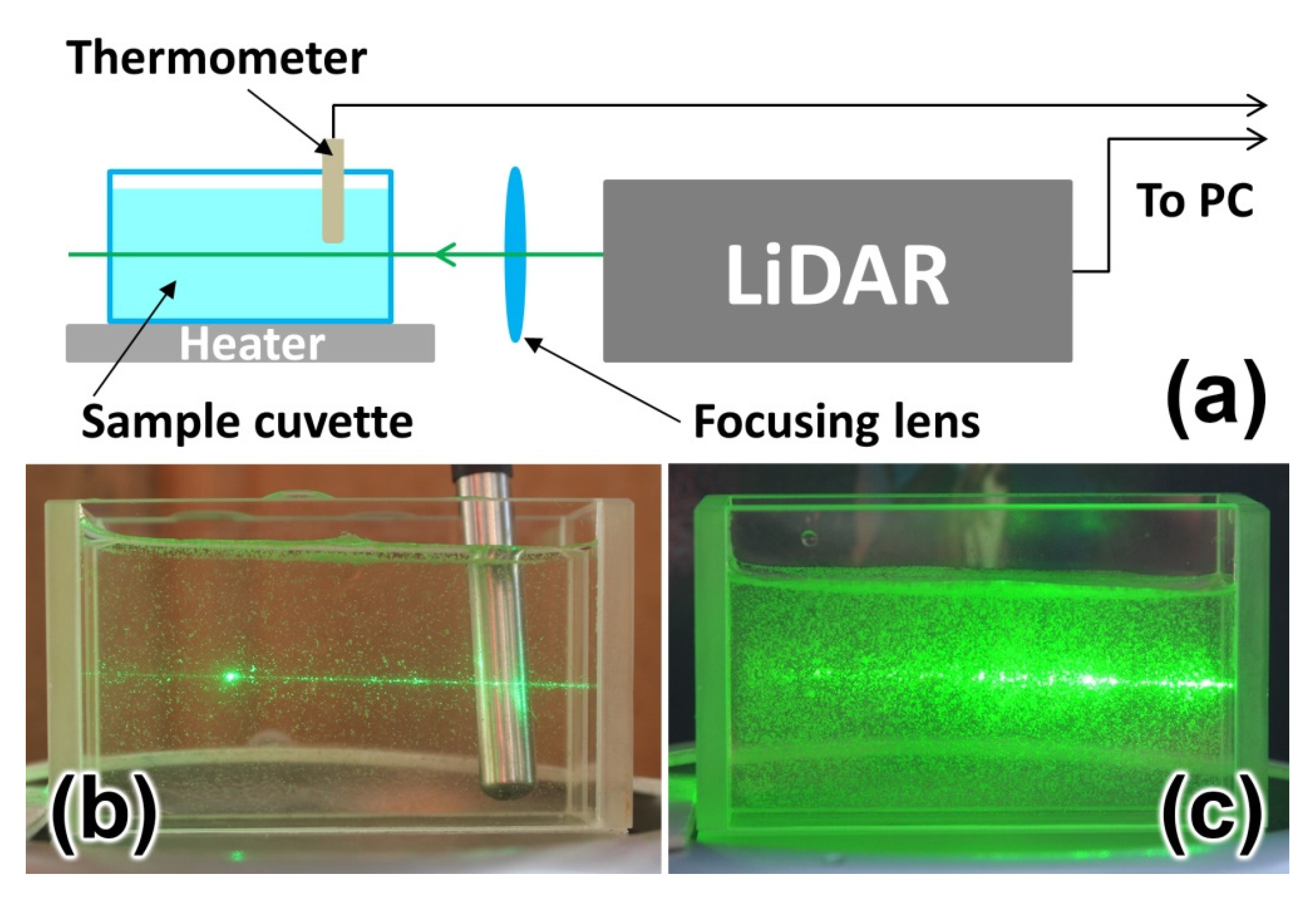

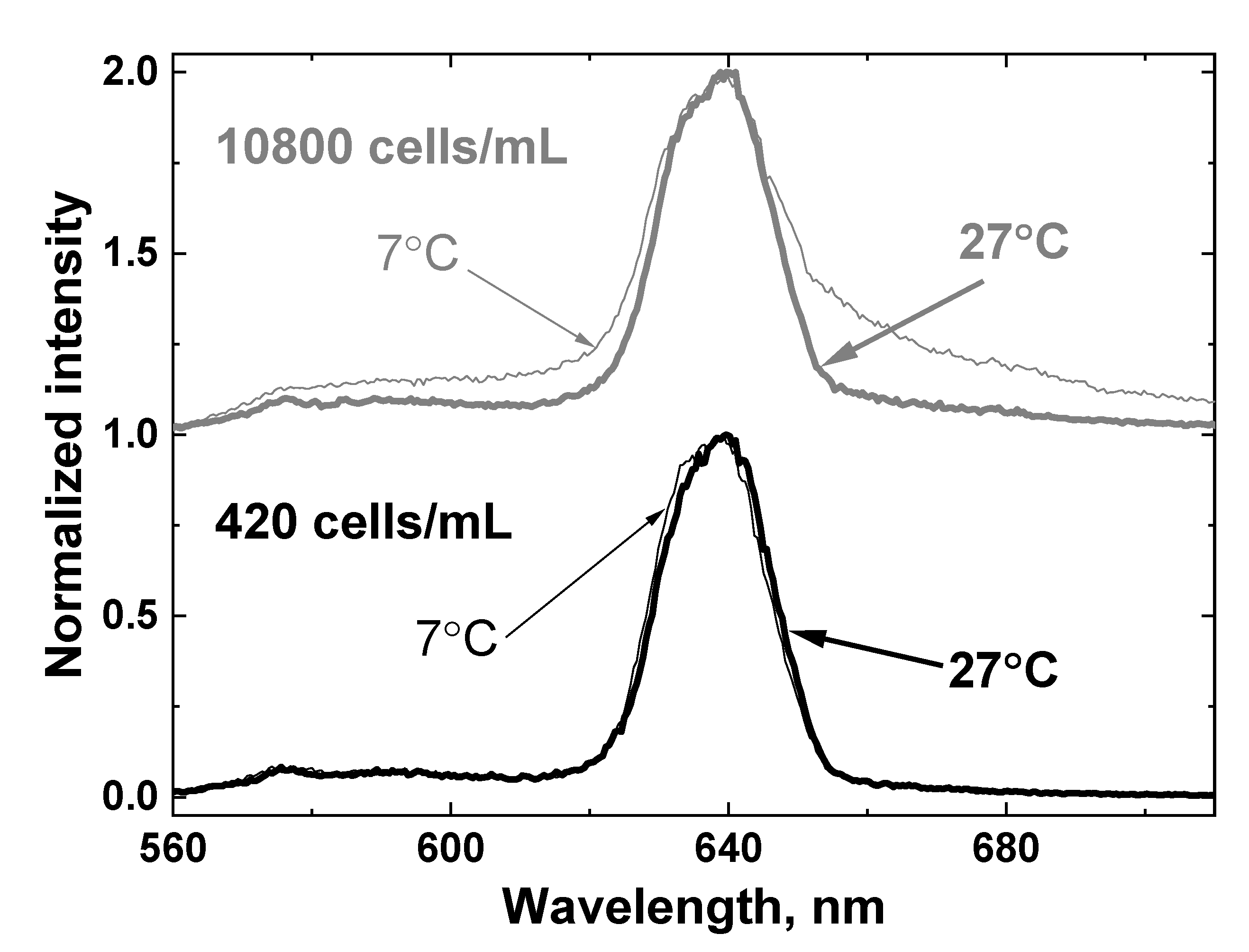

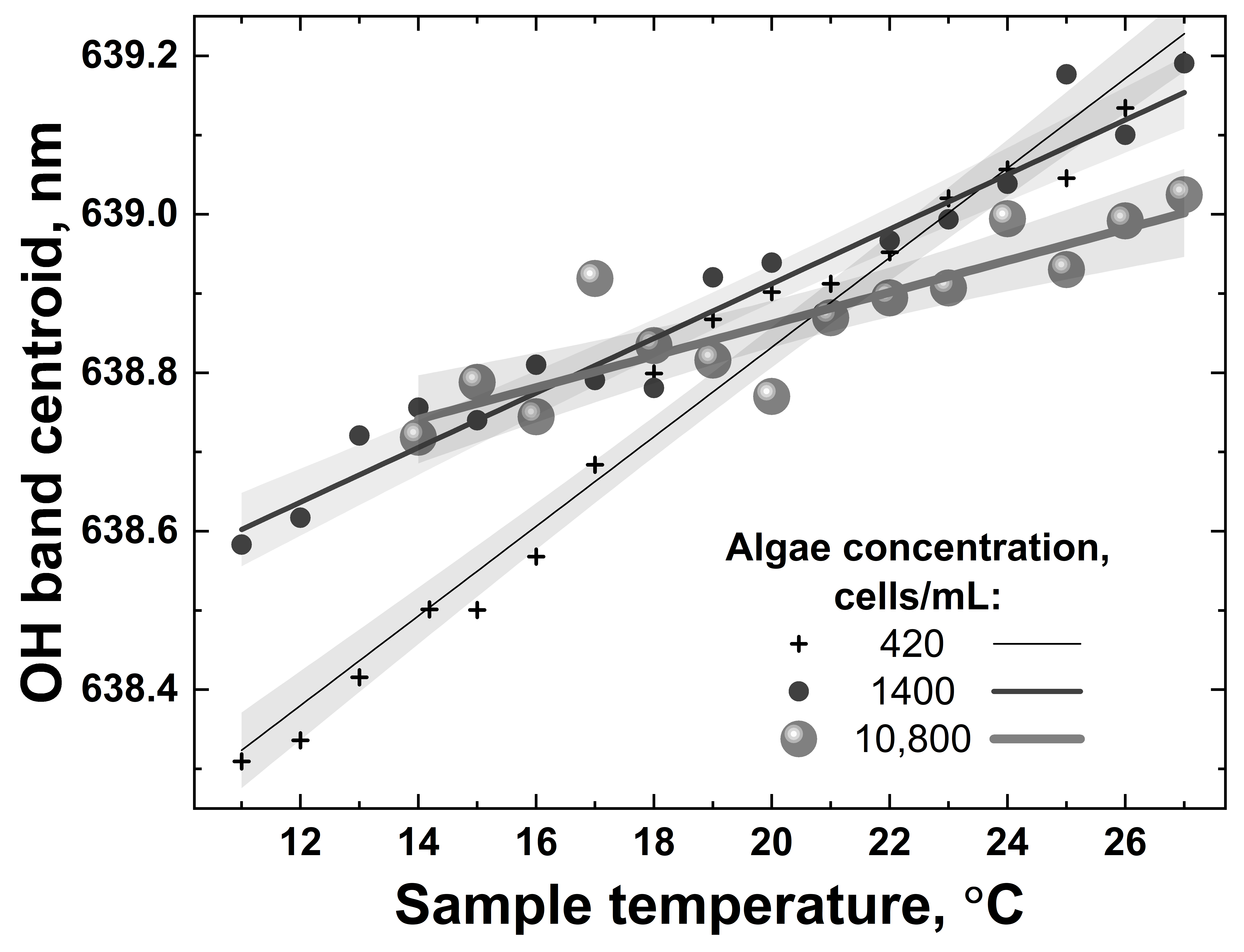
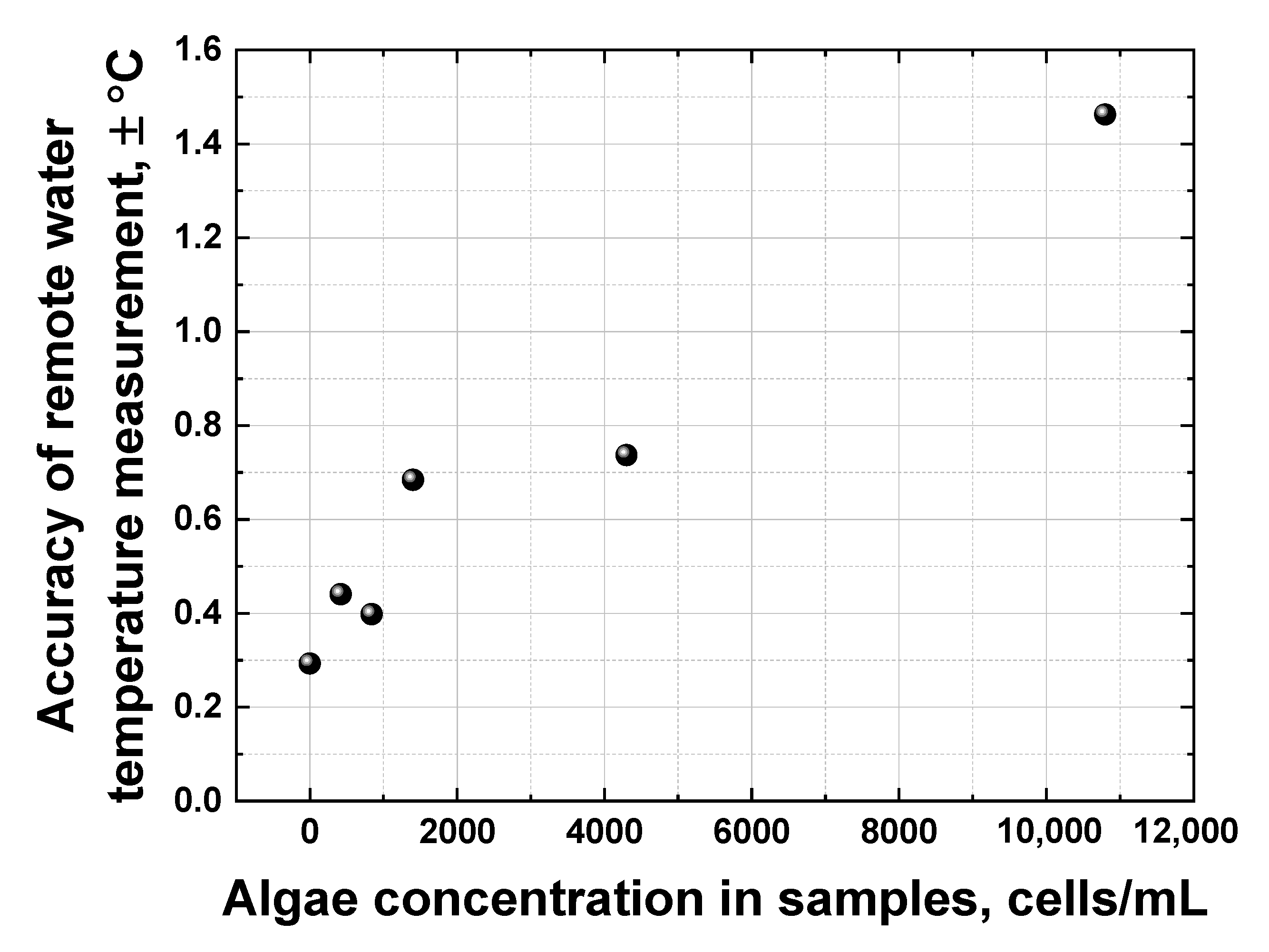
Publisher’s Note: MDPI stays neutral with regard to jurisdictional claims in published maps and institutional affiliations. |
© 2022 by the authors. Licensee MDPI, Basel, Switzerland. This article is an open access article distributed under the terms and conditions of the Creative Commons Attribution (CC BY) license (https://creativecommons.org/licenses/by/4.0/).
Share and Cite
Pershin, S.M.; Katsnelson, B.G.; Grishin, M.Y.; Lednev, V.N.; Zavozin, V.A.; Ostrovsky, I. Laser Remote Sensing of Lake Kinneret by Compact Fluorescence LiDAR. Sensors 2022, 22, 7307. https://doi.org/10.3390/s22197307
Pershin SM, Katsnelson BG, Grishin MY, Lednev VN, Zavozin VA, Ostrovsky I. Laser Remote Sensing of Lake Kinneret by Compact Fluorescence LiDAR. Sensors. 2022; 22(19):7307. https://doi.org/10.3390/s22197307
Chicago/Turabian StylePershin, Sergey M., Boris G. Katsnelson, Mikhail Ya. Grishin, Vasily N. Lednev, Vladimir A. Zavozin, and Ilia Ostrovsky. 2022. "Laser Remote Sensing of Lake Kinneret by Compact Fluorescence LiDAR" Sensors 22, no. 19: 7307. https://doi.org/10.3390/s22197307







